True Prayer: the care of the strong Christian for the health of the whole parish
 Monday, February 27, 2017 at 11:39AM
Monday, February 27, 2017 at 11:39AM
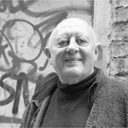
Richard Baxter, the seventeenth-century Puritan, saw the “building up of the converted” to be of the greatest importance, and he particularly emphasized the care of the strong Christian, which is so often neglected. – From True Prayer: An Invitation to Christian Spirituality, Kenneth Leech
Possibly the biggest gap in the training of clergy is our failure to help them develop a workable practical/ascetical theology. Clergy need a way of seeing the parish church as a system, and while systems theory from the behavioral sciences is useful in that regard, it isn’t enough. The need is for an understanding that grounds the parish church in the church’s self understanding.
Kilmer Myers called them the “militant core,” Martin Thornton used the term Remnant, I’ve called them “the apostolic.” All ways of referring to those parishioners who have a mature, grounded, and disciplined faith and practice. More or less; there’s no perfect.
I’ll explore two models or theories of the underlying form and dynamics of the parish church. The first is Father Thornton’s Remnant theory; the second is my Shape of the Parish model. Each sets the “strong Christian” in the context of the whole parish.
Both theories share a set of assumptions.
- The parish church is the Body of Christ in microcosm. You are the Body of Christ....That is to say; in you and through you the method and work of the Incarnation must go forward. You are meant to incarnate in your lives the themes of your adoration. You are to be taken, consecrated, broken, and made a means of grace; vehicles of the Eternal Charity. -Evelyn Underhill
- The parish exists to worship God and form the People of God. It’s primary cycle is that of Renewal-Apostolate.
- The nature and purpose of the parish gets distorted as people naturally use analogies in their attempt to understand the church. The parish is not a business, a club, a mental health center, a social service organization, or a change movement – Father Richard Norris wrote, "Church means, …a collection of people who have been called out together by a voice or a word or a summons which comes to them from outside." He noted that people compare "various associations which are consciously and voluntarily formed for the pursuit of common interests, ideals or goals. … The danger is that parishioners begin to see the parish as a "society created by human enterprise and designed to serve particular human ends," that the church itself is created by the "agreement of a number of individual persons who presumably define the terms of their association and its goals."(Richard Norris, Understanding the Faith of the Church, Seabury Press, NY, 1979)
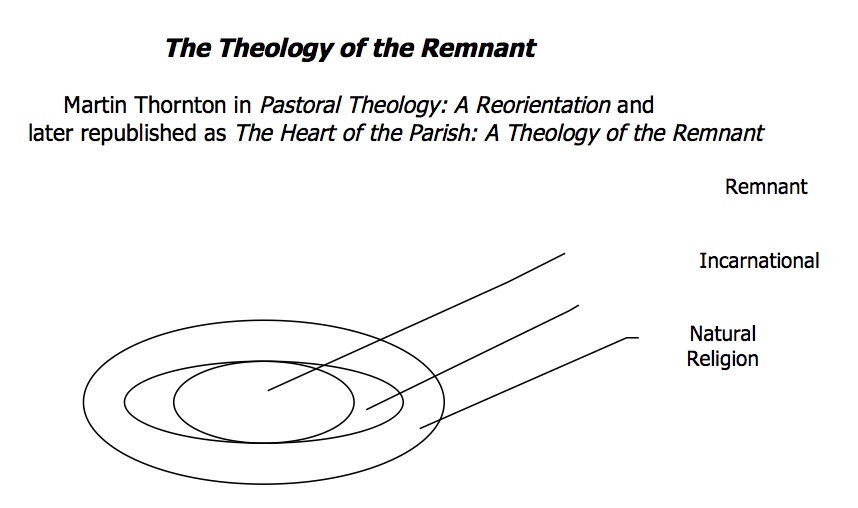 Remnant Theory
Remnant Theory
Martin Thornton was addressing the tendency for the modern parish “to lack shape and form.” He saw too many parishes as caught up in a form of religion with an emphasis on numbers, the assumption that membership was nominal, and all that resulted in a kind of conventional respectability.
For Thornton the real work of the parish priest is to know enough ascetical theology to be a coach to the faithful remnant as they develop their prayer lives. It is to be “a working partnership between two souls.” Think – coaching athletes on a football team.
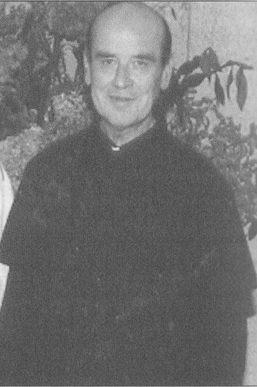 His approach was as a systems thinker (though he would not have used that term) as he set out to discover the “overall pattern, pastoral shape, form, and design” of the parish church. Take note, it was something to discover not to make up. This wasn’t a set of new ideas about making the parish successful.
His approach was as a systems thinker (though he would not have used that term) as he set out to discover the “overall pattern, pastoral shape, form, and design” of the parish church. Take note, it was something to discover not to make up. This wasn’t a set of new ideas about making the parish successful.
The parish church is the complete Body of Christ in microcosm. It contains the wholeness of the Body – it is one, holy, catholic and apostolic; it is the Body of Christ, the People of God. Its function is the cure of souls; the formation of people in Christ. And its “place” is some definable environment, usually a neighborhood, often some network of relationships with particular communities of people.
In Thornton’s scheme the parish consists of three strata or levels: the remnant, incarnational religion, and natural religion. This can be visualized as concentric circles.
Incarnational religion: babes in Christ yet rooted in Christ
I’m beginning with the second level because that’s who makes up the majority of all parish churches. Most lay leaders in most parishes are in this stratum. In our time they may be at the Eucharist frequently, or they may come once a month, but have an ascetical discipline that is shaky in other areas – disordered patterns regarding the Daily Prayers of the Church and personal devotions, an uncertain pattern of reflection, and a lack of clarity concerning service in daily living.
Some may be ready to move into a more mature pattern but their parish doesn’t offer the support and resources that would facilitate such movement.
Natural religion: a need for contemplation and adoration
This group of people response to God but not in terms of incarnational religion. They’re often tentative about the church and the sacraments. They believe in God in a broad, “the Creator,” manner. All children are at this level. Religion is an activity used to produce some benefit. So, we manipulate and do magic instead of contemplate and live in harmony. Growth comes as a kind of rapport is established with others and creation. It’s a very early form of a capacity to contemplate rather than manipulate. The task is simply to feel at home in the parish.
The Remnant: the energy from this center spreads throughout the whole body
The heart of the parish church. People with the gifts and vocation to ground the parish in Christ. A heathy remnant allows the parish to effectively and efficiently engage the mission and to manage the polarity of change and stability.
This is done in their living the Rule of the Church. By offering the Daily Prayers of the Church in communion with the whole church and on behalf of the parish. Note this isn’t praying for the parish but on behalf of the parish.
Thornton makes a point to note that this is a specialized role they play in service to the Body of Christ. It isn’t about being “better” than those at other levels. It is not the end of the journey. The movement from natural and incarnational religion to remnant is “the beginning of the journey towards sanctity in Christ.”
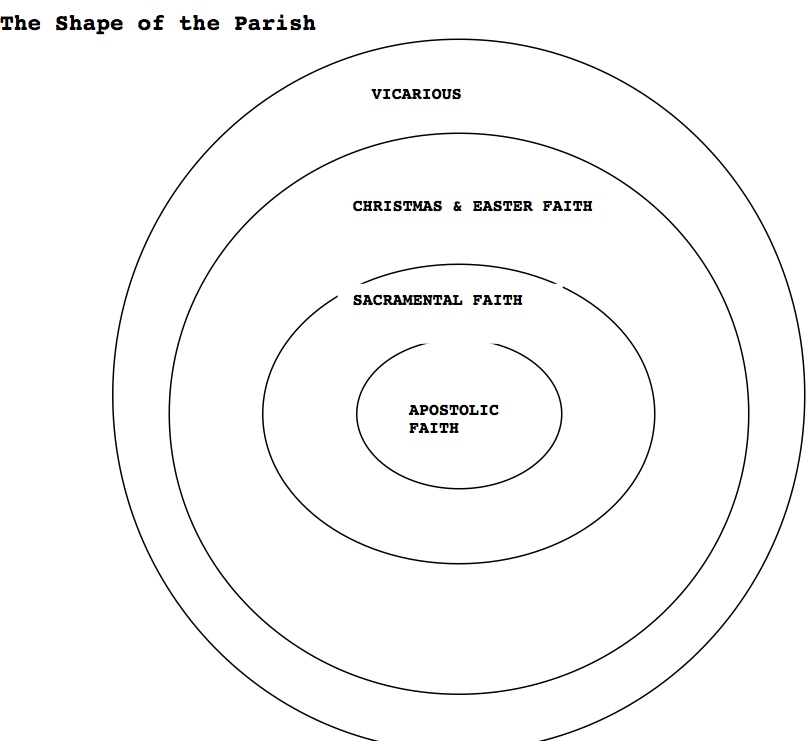 Shape of the Parish
Shape of the Parish
Shape of the Parish is one of the four models offered in Fill All Things: The Spiritual Dynamics of the Parish Church, Robert A. Gallagher, OA
This model has four levels of faith and practice: apostolic, Sacramental, Christmas & Easter, and Vicarious.
Apostolic Faith – People with a relatively disciplined, mature, full spiritual life; flexibility with self and others; an experimental and exploratory stance; competent and committed Christians
Sacramental Faith – Relatively regular about Sunday worship. Possibly beginning to see own vocation and gifts. Accept “sacramental” approach to faith – see that outward, visible, physical and particular things, people and circumstances are used by God to draw us into deeper relationship with God, self, others, creation.
Christmas & Easter Faith – Do not accept “sacramental” faith. Are members of the church.
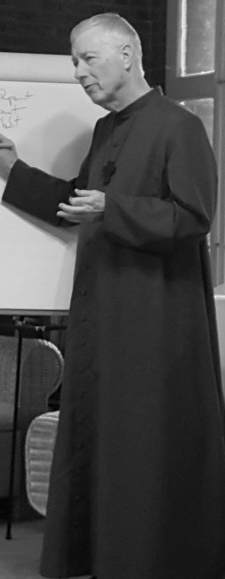 Vicarious Faith – Do not attend worship; not usually members; but may see the parish as “their parish” or be directly or indirectly influenced by the parish's life. Connected through geography, family friends.
Vicarious Faith – Do not attend worship; not usually members; but may see the parish as “their parish” or be directly or indirectly influenced by the parish's life. Connected through geography, family friends.
“The ‘Shape of the Parish’ is a critical mass theory. Critical mass theories are used by many Organization Development practitioners. The model suggests building the level of commitment, competence and emotional maturity at the center of the organization so that it grounds the system in a mission orientation and an organizational culture that supports the mission. The grounding then is enfleshed; made real in the lives of men and women. It’s in the habits of people rather than statements of leaders.
rag+
Additional Resources
Remnant Theory
Order Pastoral Theology - Thornton's explaination of the theory
Facebook page for Martin Thornton
Shape of the Parish
Order Fill All Things: The Spiritual Dynamics of the Parish Church
A two page PDF of Shape of the Parish
Power from the center pervades the whole - August 21, 2011 And an insert in the bulletin
True Prayer Postings
True Prayer: the care of the strong Christian for the health of the whole parish
True Prayer: the care of the strong Christian - often neglected #2
True Prayer: the care of the strong Christian - often neglected